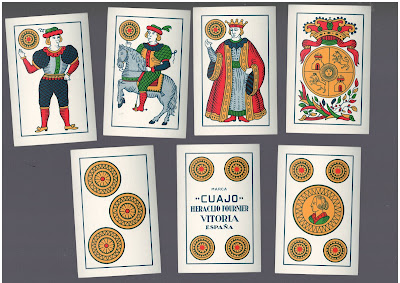Here is how the game is described in the book:
*** *** ***
LOVE'S DELIGHT;
LOVE'S DELIGHT;
Or, Game at Cards by which young People may amuse an Hour sociably, and at the same time ascertain future Events.
VENUS.
THE knave of hearts is Cupid, the rest sweethearts ; the ace of hearts, a new house; the ace of clubs, conquest ; the ace of diamonds takes all before it, and makes capture of any of the other aces; the two of diamonds is a ring and marriage, the rest of the deuces good luck; trays, surprises; fours, a long continuance in your present way of life ; fives, love meetings ; sixes, pleasure ; sevens, disappointments ; eights, mirth ; nines, changes ; tens, settlements ; queens, women ; and kings, men.Several may play at this game, there being no given number ; and let the cards be equally dealt, always leaving out ten on the board. The one that deals being first chosen by lot, each one puts on the board some trifle agreed on, and the dealer gives double ; then examine your cards, and, according to them, you will see what is speedily to come. The dealer must then call for Venus ; she is the queen of hearts, and ranks next to the ace of diamonds: as to the rest, kings take queens; queens, knaves; knaves, tens; and so on, exactly as in whist playing, and the more tricks you have, the more you have off the board on the division of the money after each game.
They that have none are sure to have no luck at all that year, and they have also to pay the sum agreed on toward the next game ; so are those who hold misfortunes, or the sevens and those who are to have the worst disappointment in love or life that can possibly happen, which comes in the shape of the nine of spades, is to pay a treble sum, and to have no cards dealt in the next round to them. The ace of diamonds only tells for one; but she who has these cards Venus and Cupid, in the same hand, clears the board of all the money on it, and ends the game ; it also tells a speedy and advantageous marriage to the single, and to a married person, it is a sure and certain sign of some important event, of a most happy and profitable nature, speedily approaching.
*** *** ***
It must be admitted that the above description is fairly rambling and imprecise. Here is what I make of the game.
Deal:
The text implies that the game is played by four persons, but as the game progresses there may be only three players.
The dealer is chosen by lot. All place a stake. Dealer places a double stake.
Deal out all the cards evenly between players. When dealing, 10 cards from the deck are left out, and are not used. ("always leaving out ten on the board") . This is not actually necessary. But it certainly makes the following stage more interesting.
When the cards are dealt, players examine their hand. The composition of the hand will tell the player's fortune in the near future.
Card/ Rank
|
Symbolizes…
|
Card/ Rank
|
Symbolizes…
|
J♥
|
Cupid
|
5
|
Love meetings
|
A♥
|
A new house
|
6
|
Pleasure
|
A♣
|
Conquest
|
7
|
Disappointments
|
2♦
|
Marriage/ A ring
|
8
|
Mirth
|
2
|
Good luck
|
9
|
Changes
|
3
|
Surprises
|
10
|
Settlements
|
4
|
"A long continuance in your
present way of life"
|
Q
|
Women
|
K
|
Men
|
Anyone who holds the 9 of spades in his hand must pay a triple sum to the pool, and sit out of the next deal.
Those who hold 7s in their hands at the start must also pay an extra sum to the next pool. I suggest increasing the stake for every seven one holds. So, having a pair of 7s pays a double sum, etc.
Anyone who holds both the Queen and Jack of hearts wins the game, and claims the whole pool. This is also a sign that they will be married soon, or their marriage will be a happy one.
Play:
The text implies that the game is a trick-taking game similar to whist . The text says the dealer's partner is the person who holds the Q♥ . The cards rank as follows:
A♦ [high]
Q♥
The rest of the aces
Kings
Queens
Jacks
( etc. )
2s [low]
Scoring:
The pool is divided proportionately to the number of tricks each player has won.
Parties who did not win any tricks must pay an extra sum to the next pool.
The Author's Suggestions:
The scoring is unusual. It is implied that the game is played in partnerships. However the scoring system is unsuited for such play. One thinks that the "partner" may refer to a partner in marriage rather than at cards.
Removing 10 cards from the deck leaves a deck of 42 cards. This is a fairly awkward number to dispose of evenly between 4 players. For 4-player games, it might be better to remove 12 cards instead. The remaining 40 cards can then be divided evenly among the players.
For three-player games I suggest removing 7 cards. The resulting deck of 45 cards can then be evenly disposed of.



















